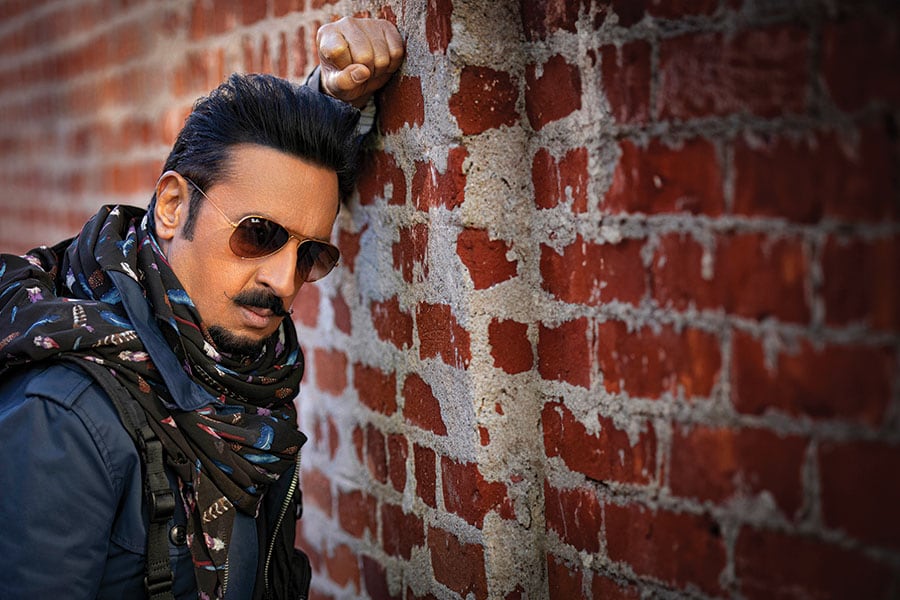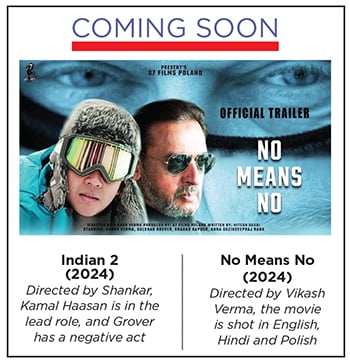
Gulshan Grover: A great bad man behind successful films
Seething eyes, menacing looks, wicked smile, ruthless demeanour, and an ominous-yet-distinct voice... for over four decades, Gulshan Grover played 'evil' roles with panache. With baddies fading fast into the sunset, the 'Bad Man' remains the last classic villainous act of Bollywood
 Gulshan Grover
Image: Ash Gupta. LA
Gulshan Grover
Image: Ash Gupta. LA
Interior. Morning. Pali Hill Bunglow. Mumbai. 1988. Jaggi, the guest, is anxious. He arrives at 7.30, a good 30 minutes ahead of scheduled time. “Can he sense my twitchiness?” the young man wonders. The host of the breakfast meeting, after all, is notorious for spotting flaws in characters, is brutal with his assessment, and has an envious track record in terms of churning incredible blockbusters such as Kalicharan, Vishwanath, Karz, Vidhaata, Hero, Meri Jung and Karma. No wonder, Mahavir is getting jittery. He drags himself towards the edge of the chair, places his elbows on the table, and props up his tapered chin with his sweaty palm. Balma’s roving eyes are hunting for the celebrated Bollywood director, and is quivering with an unknown anticipation of a windfall. “Will I get a role? What will it be?” wondered Chandar Kishan, who is still clueless about the ‘why’ behind the meeting. “It has to be a role in his movie,” Noor continued with his soliloquy.
Rewind to over one-and-a-half decade back in Delhi. On one of the fizzy Monday mornings in April, Gulshan Grover was getting ready for his afternoon school. “Focus on your studies. This is your ladder to a better life” is was what his industrious father would keep drilling into the impressionable mind of the young boy. The obedient lad lived up to the expectations. Unlike most in his class, Grover always completed his homework, was never scolded by teachers, and scored high marks. What, though, was most impressive is the way he carried himself. “My uniform was never stained with mud from the rowdy fights on the playground,” recalls Grover who was a regular part of the monkey army (Vaanar Sena) in the Ramlila that his father used to organise every year. “The first time I got picked up for the monkey army was when I was five,” he recounts, adding that the recurring annual experience made the lad fell in love with dramatics.
Meanwhile, destiny scripted a dramatic act for the young boy when he was in Class 9. Grover was getting ready for school, he packed his bag with books, samples of detergents and disinfectants, and a few chapattis wrapped in an old cloth, and started walking towards Punjabi Bagh, an affluent neighbourhood. It was a hard time for the family which was going through a prolonged and rough financial patch. Grover and his brother started doing some part-time gigs to earn some extra bucks and help the patriarch. Grover used to knock on every door, talk to the ladies, and try to convince them to buy household supplies. “It was tough to convince them,” he recalls. The women, though, fell in love with the sincerity and honesty of the good boy. “Or they might have noticed my school uniform and were moved by my plight,” he says. Whatever it be, the good boy had started winning the hearts of his consumers.
 Back in Mumbai, the meeting starts on time. Subhash Ghai plays a magnanimous host, his wife ensures that there is a lavish spread on the table, but the guest is still grappling with the chaotic fluttering of butterflies in his stomach. “Food was the last thing on my mind,” recalls Grover, who landed in Mumbai in 1975 to live his Bollywood dream. The next decade, though, turned out to be nothing less than a nightmare for the commerce grad from Shri Ram College of Commerce (SRCC) who also completed his masters and was set for a career in banking.
Back in Mumbai, the meeting starts on time. Subhash Ghai plays a magnanimous host, his wife ensures that there is a lavish spread on the table, but the guest is still grappling with the chaotic fluttering of butterflies in his stomach. “Food was the last thing on my mind,” recalls Grover, who landed in Mumbai in 1975 to live his Bollywood dream. The next decade, though, turned out to be nothing less than a nightmare for the commerce grad from Shri Ram College of Commerce (SRCC) who also completed his masters and was set for a career in banking.





 What made Grover extraordinary was the ‘extra’ that the ordinary man from Delhi had. Mahesh Bhatt explains. “He [Grover] is like a snake,” the celebrated director pointed out in his foreword which he wrote for Grover’s autobiography. “A snake, because of its ability to shed its old skin and grow a new one, is seen as a symbol of rejuvenation,” he maintained, commenting on the insane enthusiasm of the actor and his talent to deconstruct and reinvent his persona over decades. “No wonder whenever I meet him, the very first thing I say to him is “Gulshan Grover never over,” he concluded.
What made Grover extraordinary was the ‘extra’ that the ordinary man from Delhi had. Mahesh Bhatt explains. “He [Grover] is like a snake,” the celebrated director pointed out in his foreword which he wrote for Grover’s autobiography. “A snake, because of its ability to shed its old skin and grow a new one, is seen as a symbol of rejuvenation,” he maintained, commenting on the insane enthusiasm of the actor and his talent to deconstruct and reinvent his persona over decades. “No wonder whenever I meet him, the very first thing I say to him is “Gulshan Grover never over,” he concluded. 




